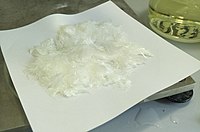
Photo from wikipedia
Abstract Recently, metal-organic frameworks with high porosity have drawn extensive attention in environment remediation. Herein, a variety of porous metal-organic frameworks were synthesized, including MIL-53(Fe), NH2-MIL-53(Fe), NO2-MIL-53(Fe) and Br-MIL-53(Fe), to… Click to show full abstract
Abstract Recently, metal-organic frameworks with high porosity have drawn extensive attention in environment remediation. Herein, a variety of porous metal-organic frameworks were synthesized, including MIL-53(Fe), NH2-MIL-53(Fe), NO2-MIL-53(Fe) and Br-MIL-53(Fe), to adsorb tetracycline (TCN) from aqueous solution. Results showed that the functionalized MIL-53(Fe) exhibited higher adsorption performance than the pristine MIL-53(Fe). Among MIL-53(Fe) series, Br-MIL-53(Fe) had the highest maximum adsorption capacity of 309.6 mg g−1. Effects of initial pH values, co-existed ions and humic acid on the adsorption performance of functionalized MIL-53(Fe) were investigated. The adsorption kinetics fitted well with pseudo-second order model and the adsorption isotherms matched Langmuir model, which suggested that the adsorption process was dominant by chemisorption and the adsorption surface was homogenous. Additionally, adsorption thermodynamics showed that the adsorption process of TCN on MIL-53(Fe) series were spontaneous and endothermic. More importantly, the functionalized MIL-53(Fe) demonstrated excellent recyclability and the detailed adsorption mechanism was discussed. Therefore, this work provided a strategy for fabrication of efficient MOFs-based adsorbent for antibiotic-containing wastewater treatment.
Journal Title: Microporous and Mesoporous Materials
Year Published: 2019
Link to full text (if available)
Share on Social Media: Sign Up to like & get
recommendations!